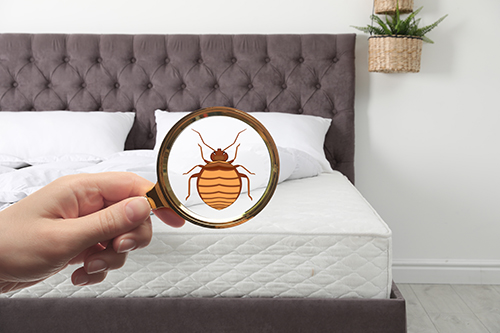 According to the CDC, while most of the time bedbugs typically live within eight feet of where people sleep, they can infest areas that don’t have any sleeping areas. They can be found in movie theaters, libraries, and yes, even found at work. Over the last several years bedbug infestations have been on the rise, and employers should take note. While the reasons for this rise are unknown, the EPA believes that increased travel, resistance to pesticides, ineffective pest control, and lack of knowledge on how to deal with the issue could all be part of the problem.
According to the CDC, while most of the time bedbugs typically live within eight feet of where people sleep, they can infest areas that don’t have any sleeping areas. They can be found in movie theaters, libraries, and yes, even found at work. Over the last several years bedbug infestations have been on the rise, and employers should take note. While the reasons for this rise are unknown, the EPA believes that increased travel, resistance to pesticides, ineffective pest control, and lack of knowledge on how to deal with the issue could all be part of the problem.
Orkin recently released their top 50 Bed Bug Cities list for 2020, and four Michigan cities are included. Detroit is ranked 7th, Grand Rapids 18th, Lansing 30th, and Flint is one spot behind in 31st. In 2018 the National Pest Management Association conducted a Bugs Without Borders survey. In the survey, pest control professionals reported that the top three places where bedbugs are typically found are single family homes at 91%, apartments/condominiums 89%, and hotels/motels 68%. But 47% of those surveyed also reported that they find bedbugs in offices.
Even closer to home, discussions at ASE member networking meetings have confirmed that the problem is neither imaginary nor isolated – bedbugs have arrived in the workplace. They are hitching rides into the office on the clothing of employees or in their purses, bags, luggage, and even their shoes.
HR professionals need to get past the initial “ick” factor and address the bedbug issues that they need to manage. The first and most obvious one is investigating to find the source of the problem; next is figuring out how to eradicate the pests; and then there is dealing with potential Workers’ Compensation claims from employees with reactions to bedbug bites.
So, when a bedbug infestation is suspected, what should HR do? According to the U.S. Occupational Safety & Health Administration (OSHA), employers have the obligation to maintain a safe workplace, including preventing “the entrance or harborage of insects.” Employers that don’t take timely steps to address bedbug infestations once they are suspected can be found liable if the bugs make their way into the homes of employees.
If an employee reports sighting of bedbugs, HR should investigate as it would with any type of issue. If there is credible evidence that a particular employee or his or her workspace is the source of the infestation, HR should meet and discuss the issue with the employee as soon as possible. The employee should be sent home immediately, placed on a leave of absence (or allowed to work remotely if possible), and required to provide proof that his or her household has been treated before the leave of absence can be ended. Often enough the employee may have difficulty paying for the cost of the home treatment; in that case the employer should consider covering the cost of the treatment in order to eliminate the problem.
You should hire a pest control agency immediately to help eliminate and prevent the spread of bedbugs in your workplace. Pest control professionals usually can help pinpoint the source of the infestation. They often use bedbug-sniffing dogs for this purpose because they can detect bedbugs and their eggs with a high degree of accuracy.
You will have to decide whether to pay the employee who must go on the leave of absence or require the employee to use PTO or vacation time, or not pay the employee at all. If the latter, do not forget FLSA issues – exempt employees must still be paid in full for any workweek during which they perform any amount of work for the employee.
Other steps you should consider taking include the following:
- Generate workers’ comp claims if necessary – Most bedbug bites are merely a nuisance, but some employees may develop allergic reactions or skin infections. These employees may qualify for workers’ compensation; claims should be reported to the employer’s carrier.
- Educate employees – Provide information on how to check for bedbugs whether at home or while traveling, and how to avoid carrying them to new locations. Both the CDC and the EPA have information available.
- Update your employee handbook – To include a policy that would require employees to report bedbug infestations whether at home or at a hotel where they have recently stayed. Develop procedures on how to investigate and react to bedbug sightings at work. Click here for a sample policy.
- Offer support to employees – Discussing the problem of a bedbug infestation will likely be difficult and embarrassing for the employee. Approach the issue with sensitivity and offer support and resources to the employee where possible. Bedbug infestations at work generally result from reintroduction versus reproduction—i.e., employees generally bring the bugs in from elsewhere. Dealing sensitively with the employee will go a long way towards eliminating the problem.
Take these steps, and your organization will be proactively prepared to deal with the issue if it arises, with minimal disruption and/or employee anxiety.
Sources: Insider 7/24/18; Pestworld.org